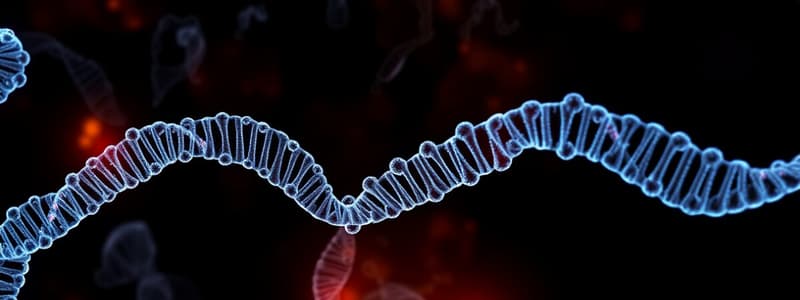Podcast
Questions and Answers
Which of the following statements about pattern formation are true? (Select all that apply)
Which of the following statements about pattern formation are true? (Select all that apply)
- Homeotic genes code for transcription factors that control the development of segment-specific body parts (correct)
- Positional information controls pattern formation (correct)
- Differential gene expression affects the developmental process in animals (correct)
- Cells receive molecular signals that communicate their position in relation to other cells (correct)
Classify each phrase or term as applying to Fly A only, Fly B only, or both Fly A and Fly B:
Classify each phrase or term as applying to Fly A only, Fly B only, or both Fly A and Fly B:
Wild type = Fly A ONLY Possesses normal Hox genes = Fly A ONLY Exhibits normal pattern formation = Fly A ONLY Exhibits abnormal pattern formation = Fly B ONLY Homeotic mutant = Fly B ONLY Possesses mutant Hox genes = Fly B ONLY Produces transcription factors triggering gene expression for segment-specific structures = Both Fly A and Fly B
A high concentration of bicoid protein at the opposite ends of a developing Drosophila embryo would result in the development of a _____
A high concentration of bicoid protein at the opposite ends of a developing Drosophila embryo would result in the development of a _____
two-headed fly
The bicoid gene product is directly responsible for _____ in a developing Drosophila embryo.
The bicoid gene product is directly responsible for _____ in a developing Drosophila embryo.
The region of a Drosophila embryo with the highest concentration of bicoid protein will develop into the _____
The region of a Drosophila embryo with the highest concentration of bicoid protein will develop into the _____
What triggers the translation of bicoid mRNA?
What triggers the translation of bicoid mRNA?
The bicoid gene is a type of _____ gene.
The bicoid gene is a type of _____ gene.
The region of a Drosophila embryo with a low concentration of bicoid protein will develop into the _____
The region of a Drosophila embryo with a low concentration of bicoid protein will develop into the _____
What process produces the gradient of bicoid protein in a fertilized egg?
What process produces the gradient of bicoid protein in a fertilized egg?
Bicoid mRNA is translated in _____
Bicoid mRNA is translated in _____
Which of these regions is most likely to develop into the Drosophila's head?
Which of these regions is most likely to develop into the Drosophila's head?
The bicoid gene is transcribed by _____
The bicoid gene is transcribed by _____
Which of the following is not a body segment of the fruit fly embryo?
Which of the following is not a body segment of the fruit fly embryo?
Which of the following statements about a gene that shows maternal effect inheritance is true?
Which of the following statements about a gene that shows maternal effect inheritance is true?
True or False? Pattern formation refers to events that organize embryonic cells in space.
True or False? Pattern formation refers to events that organize embryonic cells in space.
Where is bicoid mRNA translated?
Where is bicoid mRNA translated?
Which body part develops in regions with a low concentration of bicoid protein?
Which body part develops in regions with a low concentration of bicoid protein?
Which of the following statements about the Bicoid protein is true?
Which of the following statements about the Bicoid protein is true?
Flashcards are hidden until you start studying
Study Notes
Pattern Formation in Development
- Pattern formation describes the organization of spatial arrangement in multicellular organisms, including tissue and organ layout.
- Homeotic genes function as transcription factors regulating the development of specific body segments.
- Cells receive positional information through molecular signals that inform them of their location relative to other cells and body structures.
- Positional information is crucial in controlling the pattern formation process in developing organisms.
- Differential gene expression significantly influences developmental processes in animals.
Hox Genes and Drosophila
- Hox genes are clusters of homeotic genes present in various animals, including fruit flies, responsible for the development of segment-specific body structures post-segmentation.
- Fly A characteristics: "wild type," "normal Hox genes," and "normal pattern formation."
- Fly B characteristics: "abnormal pattern formation," "homeotic mutant," and "mutant Hox genes."
- Both flies produce transcription factors that initiate gene expression for segment-specific structures.
Bicoid Protein and Its Role
- High levels of bicoid protein at both ends of a developing Drosophila embryo result in the formation of a two-headed fly.
- The bicoid gene product establishes the anterior-posterior axis essential for proper embryonic development.
- Areas with high concentration of bicoid protein develop into head structures, while regions with low concentration develop into the abdomen.
- The gradient of bicoid protein arises via diffusion from the anterior to posterior end of the egg.
Gene Translation and Function
- Fertilization triggers the translation of bicoid mRNA, which predominantly occurs in the fertilized egg.
- Nurse cells are responsible for the transcription of the bicoid gene, providing mRNA to the developing embryo.
- The region with the highest bicoid protein concentration is destined to develop into the Drosophila head.
- A gene exhibiting maternal effect inheritance influences the offspring's phenotype based on the mother's genotype.
Miscellaneous Information
- Pattern formation is integral for organizing embryonic cells spatially.
- Antennae do not constitute a body segment in the fruit fly embryo.
- In regions of lower bicoid protein concentration, the abdomen develops as a posterior structure.
Studying That Suits You
Use AI to generate personalized quizzes and flashcards to suit your learning preferences.




